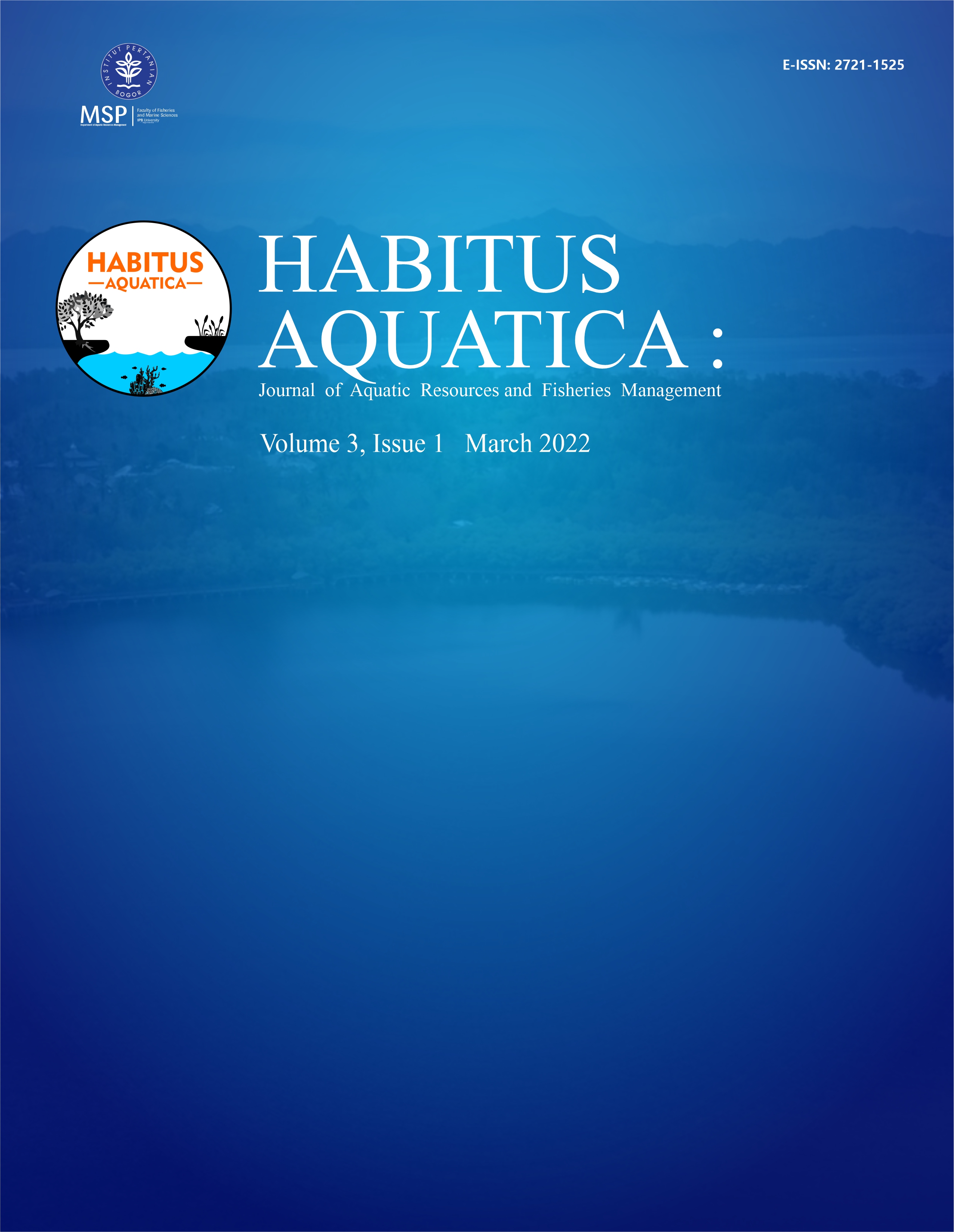Growth of Chlorella sp. and Dunaliella sp. at Different Light Intensities
Pertumbuhan Chlorella sp. dan Dunaliella sp. pada Intensitas Cahaya yang Berbeda
Abstract
Phytoplankton growth, such as Chlorella sp. and Dunaliella sp. is influenced by light intensity. The study aims to analyze the relationship between the density of Chlorella sp. and Dunaliella sp. with different light intensities. Both types of phytoplankton were grown at light intensities of 1000 lux, 3000 lux, and 7000 lux. The lighting source was obtained from a white, fluorescent lamp (cool daylight TLD). Density was observed every day for ten days using a hemocytometer. Data analysis was carried out to analyze the significance of cell growth at different light-intensity conditions. The results showed that the highest density of Chlorella sp. and Dunaliella sp. was obtained at a light intensity of 1000 lux (4.8 × 106 cells/mL and 1.33 × 106 cells/mL), while the lowest density was obtained at a light intensity of 7000 lux. The density of Chlorella sp. was more influenced by orthophosphate, while Dunaliella sp. was more influenced by the presence of nitrate. In general, it appears that differences in light intensity have a significant effect on the density of Chlorella sp. and Dunaliella sp.
Downloads
References
Andreotti V, Alessandro S, Anuta C, Francesca M, Joan G. 2019. Growth of Tetraselmis suecica and Dunaliella tertiolecta in aquaculture wastewater: numerical simulation with the bio_algae model. Wat. Air and Soil Poll. 230(3):60. DOI:10.1007/s11270-019-4122-0.
Budiardi T, Widyaya I, Wahjuningrum D. 2007. Hubungan komunitas fitoplankton dengan produktivitas udang vaname (Litopenaeus vannamei) di tambak biocrete. JAI. 6(2):119–25. DOI:10.19027/jai.6.119-125.
Cebula TA, Henrikson TE, Hartman PE, Biggley WH. 1995. Reversion profiles of cool white fluorescent light compared with far ultraviolet light: homologies and differences. Photochem. Photobiol. 61(4):353–359. DOI:10.1111/j.1751-1097.1995.tb08622.x.
Charalampous E, Matthiessen B, Sommer U. 2018. Light effects on phytoplankton morphometric traits influence nutrient utilization ability. J. Plankton Res. 40(5):568–579. DOI:10.1093/plankt/fby037.
Daiya A, Singh GP, Saini RK. 2014. A comparative study on growth of Spirulina platensis and Dunaliella salina interacted by different photoperiod and temperatures. J. Phytol. Res. 27(1&2):25–31.
Drezner Z, Turel O, Zerom D. 2010. A modified kolmogorov–smirnov test for normality. Commun. Stat - Simul. Comput. 39(4):693–704. DOI:10.1080/03610911003615816.
Fatemeh L, Mohsen D. 2016. Effects of environmental factors on the growth, optical density and biomass of the green algae Chlorella vulgaris in outdoor conditions. J. Appl. Sci. and Environ. Manage. 20(1):133–139. DOI:10.4314/jasem.v20i1.16.
Fauziah A, Bengen DG, Kawaroe M, Effendi H, Krisanti M. 2019. Hubungan antara ketersediaan cahaya matahari dan konsentrasi pigmen fotosintetik di perairan selat bali. JITKT. 11(1):37–48. DOI:10.29244/jitkt.v11i1.23108.
Félix DM, Elías JAL, Córdova AIC, Córdova LRM, González AL, Jacinto EC, Aldaz NH, Mendoza FC, Zazueta MGB. 2017. Survival of Litopenaeus vannamei shrimp fed on diets supplemented with Dunaliella sp. is improved after challenges by Vibrio parahaemolyticus. J. Invertebr. Pathol. 148:118–123. DOI:10.1016/j.jip.2017.06.003
Finkel ZV, Beardall J, Flynn KJ, Quigg A, Rees TAV, Raven JA. 2010. Phytoplankton in a changing world: cell size and elemental stoichiometry. J. Plankton Res. 32(1):119–137. DOI:10.1093/plankt/fbp098.
Gao K, Li G, Helbling EW, Villafañe VE. 2007. Variability of uvr effects on photosynthesis of summer phytoplankton assemblages from a tropical coastal area of the South China Sea. Photochem. Photobiol. 83(4):802–9. DOI:10.1111/j.1751-1097.2007.00154.x.
Gómez MP, Romeral JG, Martorell JC, Aroca AS. 2017. Direct spectrophotometric method to determine cell density of Isochrysis galbana in serial batch cultures from a larger scale fed-batch culture in exponential phase. Di dalam: Martorell JC, editor. Proceedings of MOL2NET 2017, International Conference on Multidisciplinary Sciences, 3rd Edition; 2017 Nov 27; Valencia, Spanyol. Spanyol: hlm 35–43. DOI:10.3390/mol2net-03-04632.
Gong Q, Feng Y, Kang L, Luo M, Yang Y. 2014. Effects of light and ph on cell density of Chlorella vulgaris. Energy Procedia. 61:2012–2015. DOI:10.1016/j.egypro.2014.12.064.
Hossain N, Mahlia TMI. 2019. Progress in physicochemical parameters of microalgae cultivation for biofuel production. Crit. Rev. Biotechnol. 39(6):835–859. DOI:10.1080/07388551.2019.1624945.
Jaziri AA, Guntur G, Setiawan W, Prihanto AA, Kurniawan A. 2018. Preliminary design of a low-cost greenhouse for salt production in Indonesia. IOP Conf. Ser.: Earth Environ. Sci. 137:012054. DOI:10.1088/1755-1315/137/1/012054.
Kawaroe M, Prartono T, Sunuddin A, Sari DW, Augustine D. 2009. Laju pertumbuhan spesifik Chlorella sp. dan Dunaliella sp. berdasarkan perbedaan nutrien dan fotoperiode. JJIPPI. 16(1):73–77.
Kumar D, Santhanam P, Jayalakshmi T, Nandakumar R, Ananth S, Devi AS, Prasath BB. 2015. Excessive nutrients and heavy metals removal from diverse wastewaters using marine microalga Chlorella marina (Butcher). Indian J. Mar. Sci. 44(1):97–103.
Kusdarwati R, Akhyar M, Rahardja B. 2019. Pengaruh penambahan vitamin b pada media blotong 12 kering terhadap pertumbuhan populasi Dunaliella salina. JIPK. 3(1):73–77. DOI:10.20473/jipk.v3i1.11628.
Lee HB, Katz GS, Restori AF. 2010. A monte carlo study of seven homogeneity of variance tests. J. Math. Stat. 6(3):359–366.
Li S, Zheng X, Chen Y, Song C, Lei Z, Zhang Z. 2020. Nitrite removal with potential value-added ingredients accumulation via Chlorella sp. L38. Bioresour. Technol. 313. DOI:10.1016/j.biortech.2020.123743.
Lu BL, Li MX, Qi L. 2013. The effect of light on the growth and product accumulation of Chlorella. Adv. Mat. Res. 724–725(2013):323–329. DOI:10.4028/www.scientific.net/AMR.724-725.323.
Metsoviti MN, Papapolymerou G, Karapanagiotidis IT, Katsoulas N. 2019. Effect of light intensity and quality on growth rate and composition of Chlorella vulgaris. Plants. 9(1):1–17. DOI:10.3390/plants9010031.
Pachiappan P, Prasath BB, Perumal S, Devi AS, Kumar SD. 2015. Isolation and culture of microalgae. Di dalam: Perumal P editor. Advances in Marine and Brackishwater Aquaculture. New Delhi: Springer India. hlm 1–15. DOI:10.1007/978-81-322-2271-2_1.
Paiki K, Kalor J. 2017. Distribusi nitrat dan fosfat terhadap kepadatan fitoplankton di peraiaran pesisir Yapen Timur. J. Fish. Mar. Sci. 1(2):63–71.
Pakravan S, Akbarzadeh A, Sajjadi MM, Hajimoradloo A, Noori F. 2018. Chlorella vulgaris meal improved growth performance, digestive enzyme activities, fatty acid composition and tolerance of hypoxia and ammonia stress in juvenile Pacific white shrimp Litopenaeus vannamei. Aquac. Nutr. 24(1):594–604. DOI:10.1111/anu.12594.
Pisal D, Lele S. 2005. Carotenoid production from microalga, Dunaliella salina. Indian J Biotechnol. 4:476–473.
Provasoli L, McLaughin JJA, Droop MR. 1957. The development of artificial media for marine algae. Archiv. Microbiol. 25:392–428. DOI: 10.1007/BF00446694
Rai M, Gautom T, Sharma N. 2015. Effect of salinity, ph, light intensity on growth and lipid production of microalgae for bioenergy application. Online J. Biol. Sci. 15(4):260–267. DOI:10.3844/ojbsci.2015.260.267.
Raja R, Shanmugam H, Ganesan V, Carvalho IS. 2014. Biomass from microalgae: an overview. Oceanography. 2(1):118–124. DOI:10.4172/2332-2632.1000118.
Ras M, Steyer J, Bernard O. 2013. Temperature effect on microalgae: a crucial factor for outdoor production. Rev. Environ. Sci. Biotechnol. 12(2):153–164. DOI:10.1007/s11157-013-9310-6.
Rumanti M, Rudiyanti S, Nitisupardjo M. 2014. Hubungan antara kandungan nitrat dan fosfat dengan kepadatan fitoplankton di sungai bremi Kabupaten Pekalongan. MAQUARES. 3(1):168–176. DOI:10.14710/marj.v3i1.4434.
Salmaso N, Luigi NL, Judit P. 2015. Functional classifications and their application in phytoplankton ecology. Freshw. Biol. 60(4):603–619. DOI:10.1111/fwb.12520.
Satriaji D, Zainuri M, Widowati I. 2016. Cultivated in different culture media and light intensity. J. Teknol. 78(4–2):27–31.
Seepratoomrosh J, Pokethitiyook P, Meetam M, Yokthongwattana K, Yuan W, Pugkaew W, Kangvansaichol K. 2016. The effect of light stress and other culture conditions on photoinhibition and growth of Dunaliella tertiolecta. Appl. Biochem. Biotechnol. 178(2):396–407. DOI:10.1007/s12010-015-1882-x.
Setiasih I, Sabdono A, Pramesti R. 2020. Pengaruh salinitas terhadap pertumbuhan dan aktivitas antioksidan Dunaliella salina (Chlorophyceae: Dunaliellaceae). J. Mar. Res. 9(2):181–185. DOI:10.14710/jmr.v9i2.27028.
Singh S, Singh P. 2015. Effect of temperature and light on the growth of algae species: A review. Renew. Sust. Energ. Rev. 50(2015):431–444. DOI:10.1016/j.rser.2015.05.024.
Sukri SM, Saad CR, Kamarudin MS, Yasin I. 2016. Effect of different levels of Chlorella meal on growth and survival of freshwater prawns Macrobrachium rosenbergii juvenile. Songklanakarin J. Sci. Technol.. 38(6):641–644.
Widiatmaka W, Ambarwulan W, Setiawan Y, Purwanto MYJ, Taryono T, Effendi H. 2016. Land use planning for brackish water shrimp ponds in the north coast of Tuban, Indonesia. Indones. J. Geogr. 4(2):194–211. DOI:10.22146/ijg.9268.
Wimalasekera R. 2019. Effect of light intensity on photosynthesis. Di dalam Ahmad P, Ahanger MA, Alyemeni MN, Alam P. Photosynthesis, Productivity and Environmental Stress. 1st edn. Wiley. hlm 65–73. DOI:10.1002/9781119501800.ch4.
Yaakob M, Mohamed RMSR, Al-Gheethi A, Gokare RA, Ambati RR. 2021. Influence of nitrogen and phosphorus on microalgal growth, biomass, lipid, and fatty acid production: an overview. Cells. 10(2):393–412. DOI:10.3390/cells10020393.
Copyright (c) 2024 Habitus Aquatica

This work is licensed under a Creative Commons Attribution-ShareAlike 4.0 International License.
Authors submitting manuscripts should understand and agree that copyright of manuscripts of the article shall be assigned/transferred to Habitus Aquatica Journal. This work is licensed under a Creative Commons Attribution-ShareAlike 4.0 International License (CC BY-SA). Therefore, Authors and Readers are permitted to share — copy and redistribute the material in any medium or format, and adapt — remix, transform, and build upon the material for any purpose. However, they must give appropriate credit, provide a link to the license, and indicate if changes were made. If you remix, transform or build upon the material, you must distribute your contributions under the same license as the original.


















